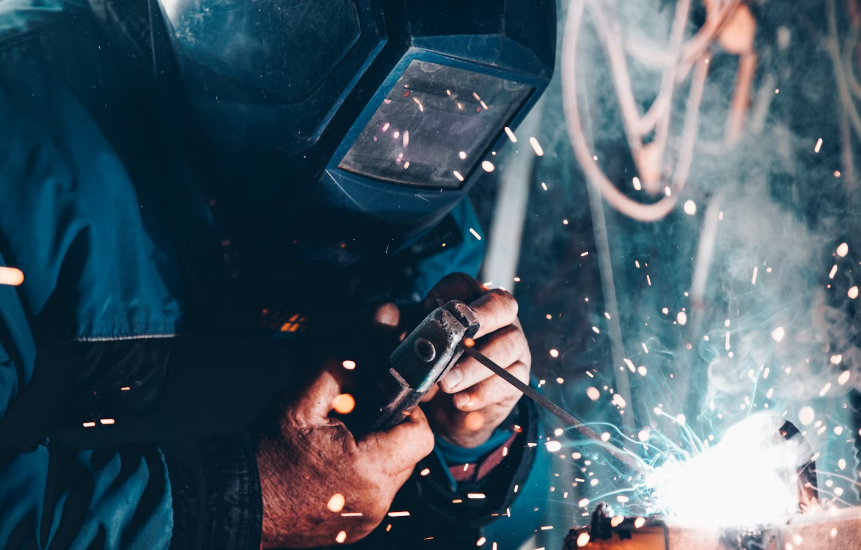The Future of Welded Manufacturing – Mia Makina
As the welded manufacturing sector continues to evolve, the integration of advanced welding technology and the development of specialized expertise are essential for staying competitive. Innovations such as automated welding systems, robotic welding, and digital transformation in welding are transforming the industry, enhancing efficiency, precision, and sustainability. In this article, we explore the latest technological innovations in welded manufacturing, the impact of quality control standards, and the future skills and training requirements needed to harness these advancements. Discover how the synergy of technology and expertise is shaping the future of welded manufacturing.
Technological Revolution in the Welded Manufacturing Sector
The welding industry has undergone a significant transformation, transitioning from traditional manual methods to modern automated welding systems. Traditional welding techniques, while effective, often relied heavily on the skill and precision of the welder, leading to variability in quality and efficiency. These methods were labor-intensive, time-consuming, and sometimes posed safety risks due to the close proximity of workers to high temperatures and hazardous materials.
In contrast, automated welding systems have revolutionized the industry by introducing precision, consistency, and enhanced safety. These systems utilize advanced technologies such as computer numerical control (CNC machining) and robotics to perform complex welds with high accuracy. Automation reduces human error, ensures uniform quality across production batches, and significantly speeds up the welding process. By minimizing manual intervention, automated systems also improve workplace safety, allowing operators to manage the process from a safe distance.
Significant Developments and Innovations in Welding Technology in Recent Years

The past few years have seen remarkable advancements in welding technology, driven by the need for greater efficiency, precision, and sustainability. Some of the most significant developments include:
- Robotic Welding: The integration of robotics in welding has enabled the automation of highly complex and repetitive welding tasks. Robotic welding systems are programmable and can be adjusted for different welding projects, offering unmatched flexibility and precision. The use of sensors and AI in robotic systems further enhances their capabilities, allowing real-time adjustments to ensure optimal weld quality.
- High-Precision Welding Techniques: Innovations such as laser welding and friction stir welding have set new standards for precision and quality in the welding industry. Laser welding uses focused laser beams to achieve fine, high-quality welds with minimal distortion, making it ideal for delicate and high-precision applications. Friction stir welding, which joins materials without melting them, provides strong and defect-free welds, particularly useful in aerospace and automotive industries.
- Digital Transformation in Welding: The digitalization of welding processes has introduced tools like digital twins, IoT-enabled devices, and advanced analytics. These technologies provide real-time monitoring and data collection, allowing for predictive maintenance and process optimization. Digital transformation enhances transparency and control over welding operations, leading to improved productivity and reduced downtime.
- Sustainable Welding Practices: The push towards sustainability has led to the development of eco-friendly welding technologies and materials. Techniques that reduce energy consumption and minimize waste, such as cold metal transfer (CMT) welding, are gaining traction. These sustainable practices not only lower environmental impact but also reduce costs associated with energy and material usage.
By embracing these technological advancements, the welded manufacturing sector is poised to achieve unprecedented levels of efficiency, quality, and sustainability. The shift from traditional methods to modern automated welding systems marks a pivotal moment in the industry’s evolution, highlighting the importance of continuous innovation and expertise in driving progress.
The Role of Expertise and Competence
While technological advancements in welding technology have greatly enhanced the capabilities and efficiency of the welded manufacturing sector, the human factor remains a crucial element in ensuring high-quality outcomes. The precision and reliability of automated welding systems depend significantly on the expertise of the professionals who design, program, and oversee these processes. Skilled welders and engineers bring a deep understanding of materials, welding techniques, and potential challenges that can arise during manufacturing.
Human expertise is essential in settings where automated systems might encounter complex or unusual welding tasks that require adaptive problem-solving and hands-on adjustments. The ability to interpret and respond to subtle cues during the welding process—such as changes in the color of the weld pool or unexpected material behavior—requires a level of experience and intuition that technology alone cannot replicate. Therefore, the quality of welded manufacturing is not only a function of advanced machinery but also the knowledge and skills of the people operating them.
The Role of Expert Welders and Engineers: Integrating Knowledge and Experience with Technology
Expert welders and engineers play a pivotal role in integrating cutting-edge technology with practical knowledge and experience. Their expertise is essential for several key reasons:
- Program Development and Optimization: Experienced welders and engineers are responsible for developing and optimizing the programs that control automated welding systems. Their understanding of welding dynamics allows them to set parameters that ensure the best possible results, adapting to different materials and project specifications.
- Quality Control and Assurance: Even with advanced quality control standards and automated monitoring systems, human oversight is critical. Expert welders and engineers can conduct thorough inspections and make precise adjustments that automated systems might miss. Their ability to detect and address potential issues early in the process helps maintain consistent quality and prevent costly rework.
- Training and Skill Development: As welding technology evolves, continuous training and skill development are necessary to keep pace with new tools and techniques. Expert welders and engineers serve as mentors and trainers, sharing their knowledge with the next generation of professionals. This transfer of expertise ensures that the workforce remains proficient and capable of leveraging the latest advancements in welding technology.
- Innovation and Problem-Solving: Experienced professionals are often at the forefront of innovation, using their deep understanding of welding processes to develop new techniques and solutions. Their ability to troubleshoot and solve complex problems contributes to the continuous improvement of welding methods and technologies.
- Sustainable Practices: With the growing emphasis on sustainable production methods in the welding sector, expert welders and engineers are instrumental in implementing eco-friendly practices. Their expertise helps identify opportunities for energy savings, waste reduction, and the use of environmentally friendly materials.
In conclusion, while advanced welding technology and automated systems are transforming the welded manufacturing industry, the human factor remains indispensable. The integration of expert knowledge and experience with cutting-edge technology ensures that manufacturing processes are efficient, high-quality, and innovative. As the industry continues to evolve, the role of skilled welders and engineers will be critical in maintaining and advancing the standards of welded manufacturing.
The Rise of Automation and Robotic Systems
The adoption of robotic systems and automation in welding processes marks a significant shift towards more efficient, precise, and safe manufacturing practices. Robotic welding systems are equipped with advanced sensors, controllers, and software that enable them to perform complex welding tasks with high accuracy. These systems can be programmed to execute repetitive welds consistently, reducing the risk of human error and ensuring uniform quality across production runs.
Automation in welding processes offers several key advantages:
- Increased Productivity: Automated welding systems can operate continuously without fatigue, significantly boosting production rates. This constant operation allows manufacturers to meet high-volume demands and tight deadlines more effectively.
- Consistency and Precision: Robots follow precise programming, ensuring that each weld is identical. This level of consistency is challenging to achieve with manual welding, where variability can occur due to human factors.
- Reduced Waste: The precision of robotic welding minimizes material waste, as the robots execute welds accurately and efficiently. This optimization leads to cost savings and more sustainable production practices.
- Enhanced Safety: Automation reduces the need for workers to perform dangerous tasks in close proximity to high temperatures and hazardous fumes. By taking on these risky jobs, robots improve workplace safety and reduce the likelihood of accidents and injuries.
Robotic Welding Solutions that Enhance Efficiency and Safety on Production Lines
Robotic welding solutions have revolutionized production lines by enhancing both efficiency and safety. Here are some of the ways in which robotic welding contributes to these improvements:
High-Speed Operations: Robotic welding systems are capable of operating at speeds much higher than those achievable by human welders. This high-speed capability shortens production cycles, enabling faster turnaround times for large-scale manufacturing projects.
- Real-Time Monitoring and Adjustments: Modern robotic welding systems are equipped with sensors and monitoring tools that provide real-time feedback on the welding process. This data allows the system to make immediate adjustments to maintain optimal welding conditions, ensuring consistent quality and reducing the need for rework.
- Flexible and Adaptive Systems: Robotic welding solutions are highly adaptable, capable of handling a variety of welding tasks and materials. These systems can be reprogrammed quickly to accommodate different product designs and specifications, making them ideal for industries with diverse and changing production needs.
- Integrated Safety Features: Robotic welding systems are designed with integrated safety features, such as collision detection and emergency stop functions. These features protect both the equipment and human workers, ensuring a safer working environment. Additionally, the use of robots in hazardous areas reduces human exposure to dangerous conditions.
- Advanced Welding Techniques: Robots can perform advanced welding techniques, such as multi-axis welding, that are difficult or impossible for human welders to execute. These techniques enable the production of complex and high-precision components, expanding the possibilities for innovative product designs.
- Reduced Labor Costs: By automating repetitive and labor-intensive welding tasks, manufacturers can reduce labor costs and allocate human workers to more strategic roles. This shift not only lowers operational expenses but also improves overall workforce utilization.
In conclusion, the rise of automation and robotic systems in welding processes represents a significant advancement in the manufacturing sector. These technologies enhance productivity, consistency, and safety on production lines, providing substantial benefits to manufacturers. As the industry continues to evolve, the integration of robotic welding solutions will play a crucial role in driving efficiency and innovation in welded manufacturing.
Education and Skill Development
In the face of rapid technological advancements, the welding industry must prioritize continuous education and skill development for welders and engineers. The integration of welding technology, such as automated systems and robotic welding, demands that professionals stay current with the latest innovations and methodologies. Here’s how the industry is adapting:
Ongoing training programs are essential to keep up with evolving technologies. Welders and engineers must engage in regular training, often provided by industry associations and equipment manufacturers. These programs cover new welding techniques, the operation of advanced machinery, and updated safety protocols. Continuous education ensures that professionals are proficient in using state-of-the-art welding technology and adhering to best practices.
Workshops and seminars offer hands-on experience with the latest welding technologies and practices. Attending these events provides opportunities to learn from industry experts, engage in practical demonstrations, and network with peers. Such interactions foster a deeper understanding of emerging trends and innovations.
With the rise of digital education, online learning platforms have become invaluable resources. Online courses and virtual training modules offer flexible learning schedules, enabling professionals to update their skills at their convenience. These platforms ensure access to the latest educational content, regardless of geographic location.
The Future of Expertise Requirements in the Sector and Strategies for Talent Development
Looking ahead, the expertise requirements in the welding sector will continue to evolve alongside technological advancements. To meet these future demands, strategic talent development initiatives are crucial:
Emphasizing STEM education is fundamental. Encouraging students to pursue science, technology, engineering, and mathematics (STEM) education equips future welders and engineers with the analytical and technical skills needed to innovate and excel in a technology-driven industry.
Collaborative industry-academia programs can create specialized educational programs tailored to the needs of the welding sector. Partnerships between industry and academic institutions ensure that curricula are aligned with current industry demands, providing students with relevant and practical skills.
Apprenticeship and mentorship programs offer practical, hands-on training that bridges the gap between theoretical knowledge and real-world application. Learning under the guidance of experienced professionals helps develop highly skilled welders and engineers capable of tackling complex welding tasks.
Focusing on soft skills is essential. In addition to technical expertise, soft skills such as problem-solving, critical thinking, and effective communication should be incorporated into training programs. This prepares professionals for leadership roles and collaborative environments.
Leveraging advanced training tools such as simulation software, virtual reality (VR), and augmented reality (AR) provides immersive and interactive learning experiences. These tools allow professionals to practice complex welding tasks in a controlled environment, enhancing their proficiency and confidence.
Conclusion: The Combination of Innovation and Expertise in the Welded Manufacturing Sector
In the welded manufacturing sector, the synergy between innovation and expertise is crucial for maintaining a competitive edge. Technological advancements such as automated welding systems, robotic welding, and digital transformation are revolutionizing the industry, enhancing efficiency, precision, and sustainability. However, the successful integration of these technologies depends heavily on the expertise and continuous education of welders and engineers.
The rise of automation and robotic systems has significantly improved production capabilities, ensuring consistent quality and reducing human error. These advancements, coupled with sustainable and eco-friendly practices, are paving the way for a more efficient and responsible manufacturing process. Nonetheless, the human factor remains irreplaceable. Expert welders and engineers bring invaluable knowledge and problem-solving skills that are essential for adapting to new technologies and overcoming complex challenges.




